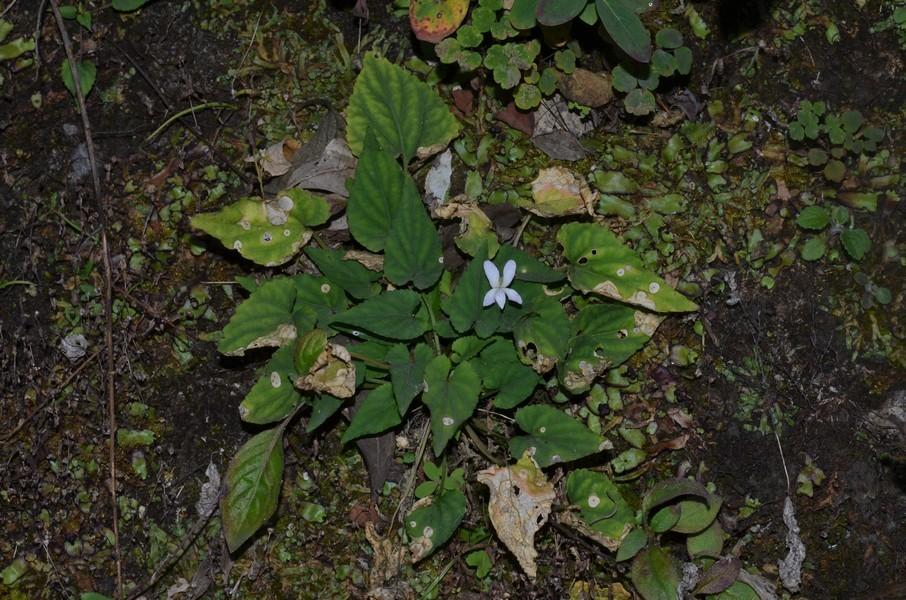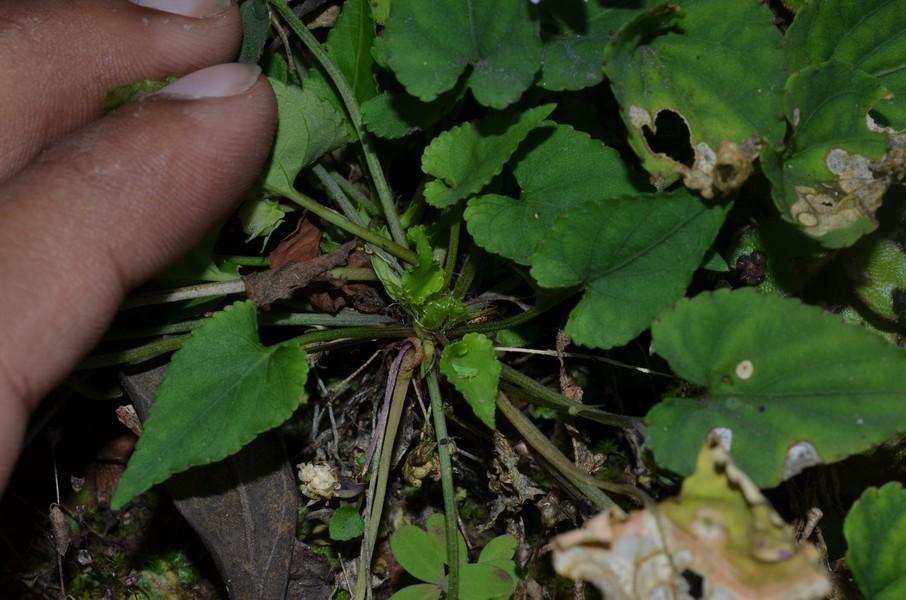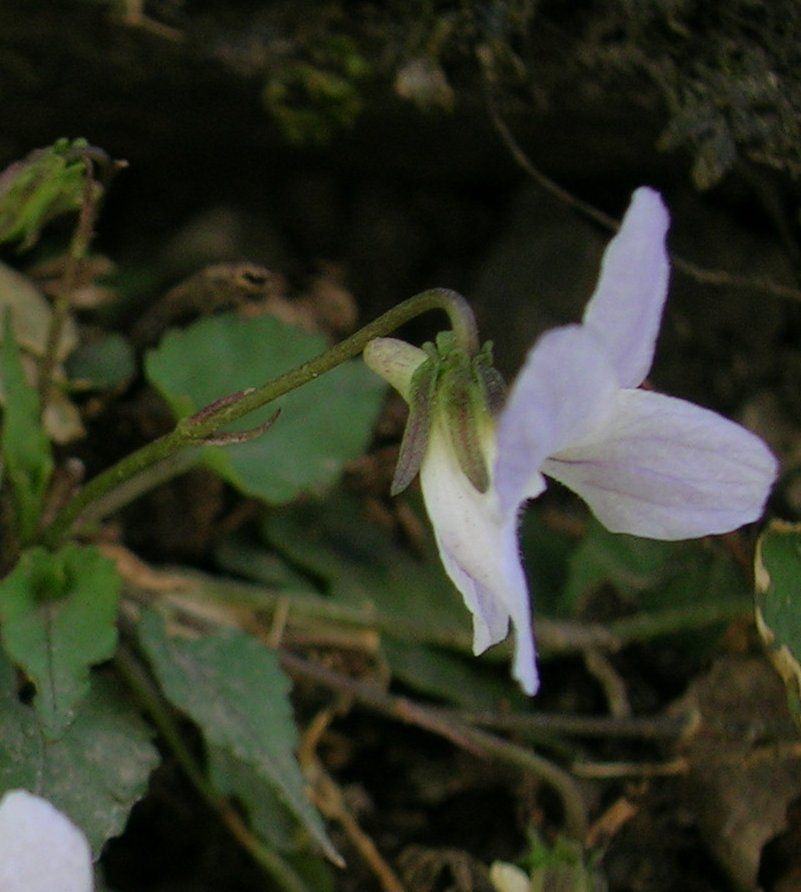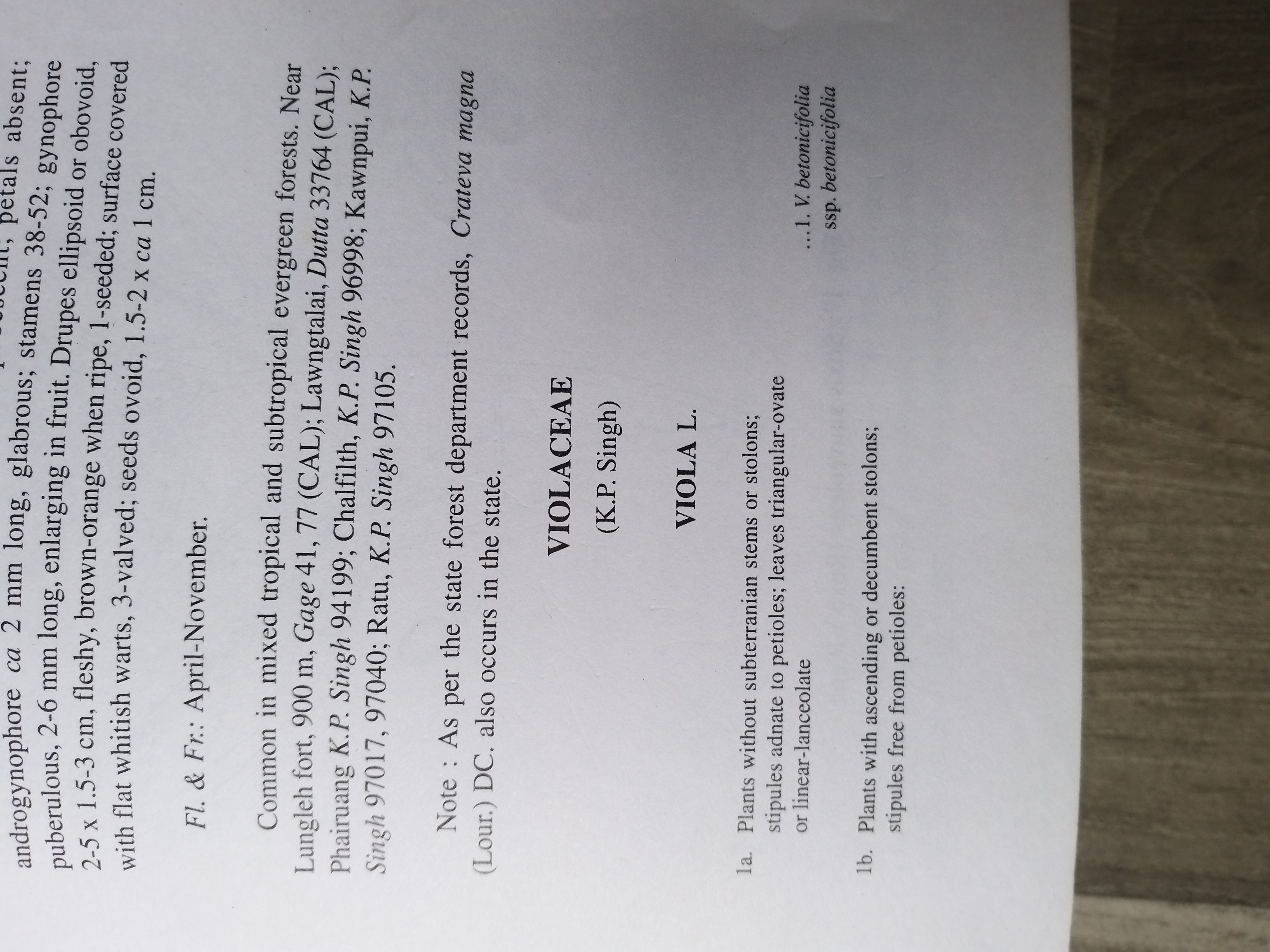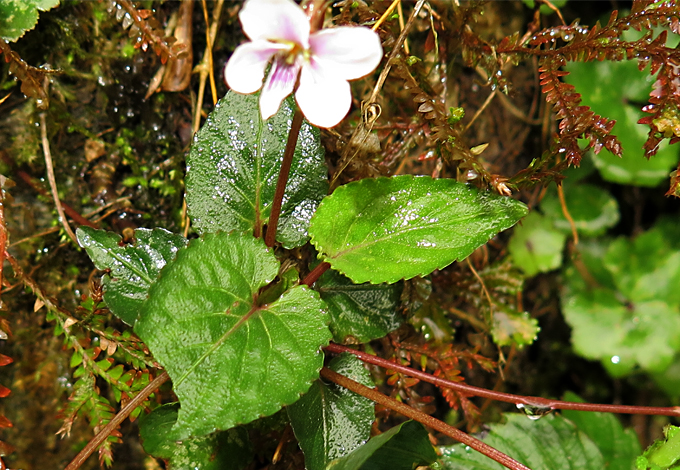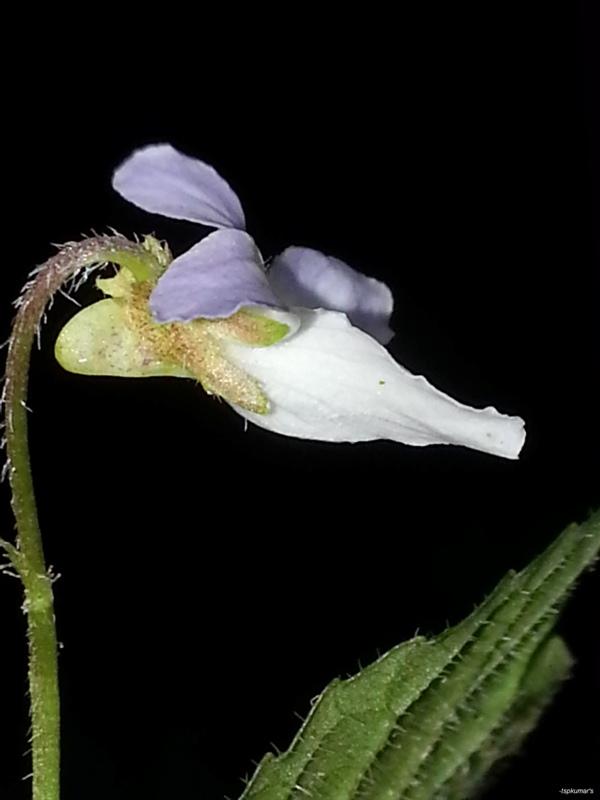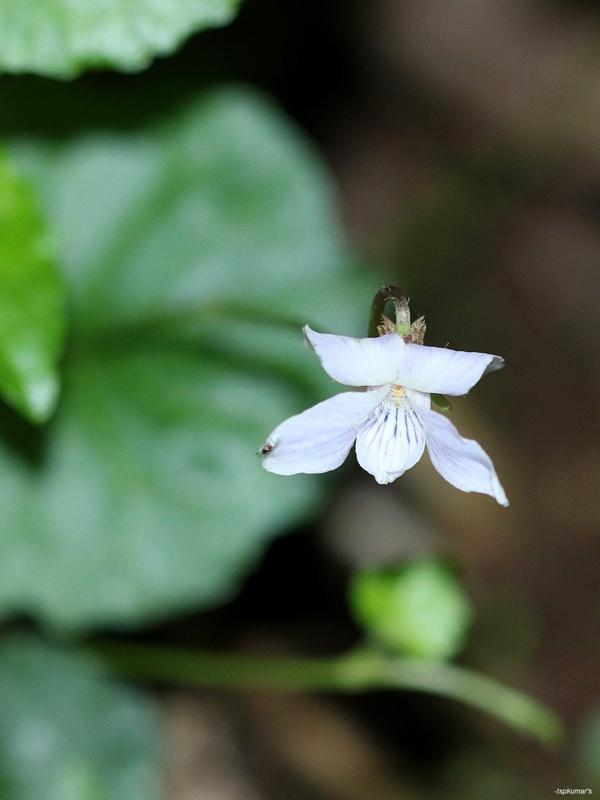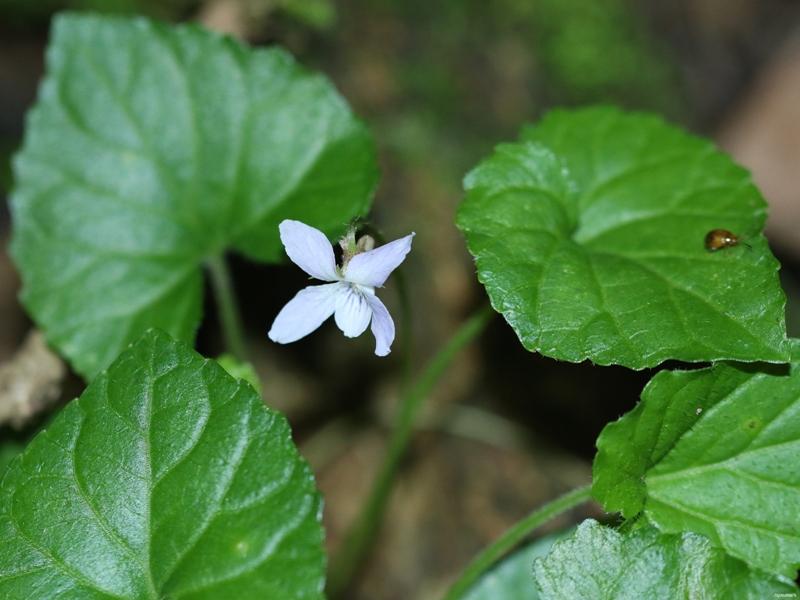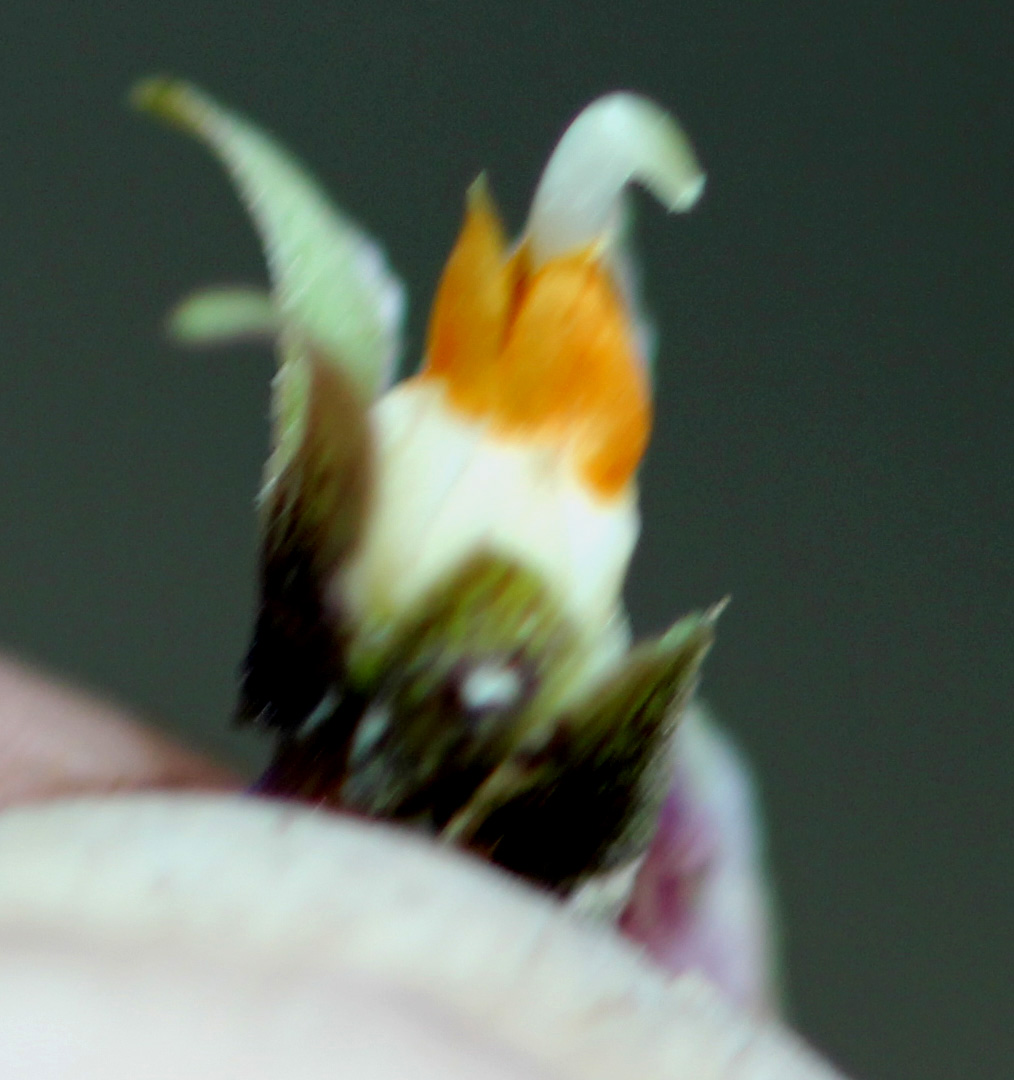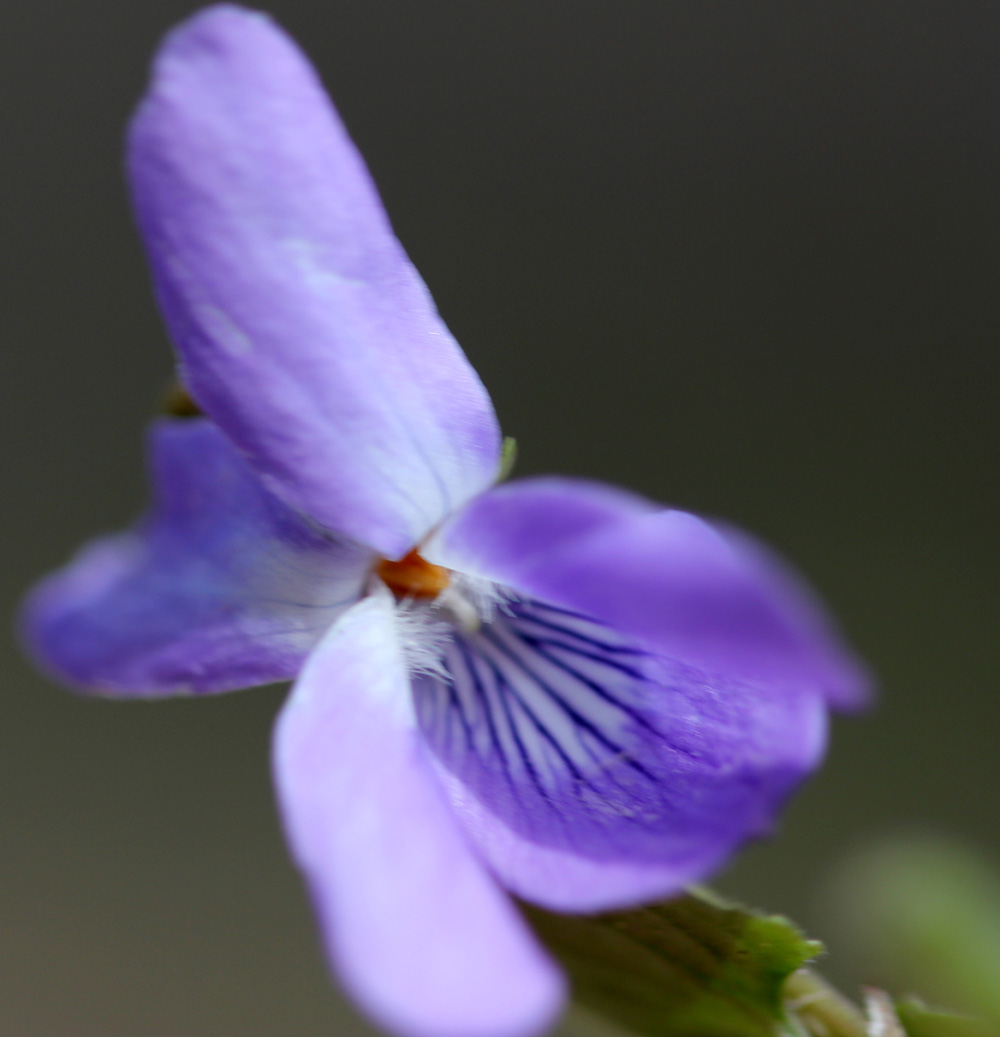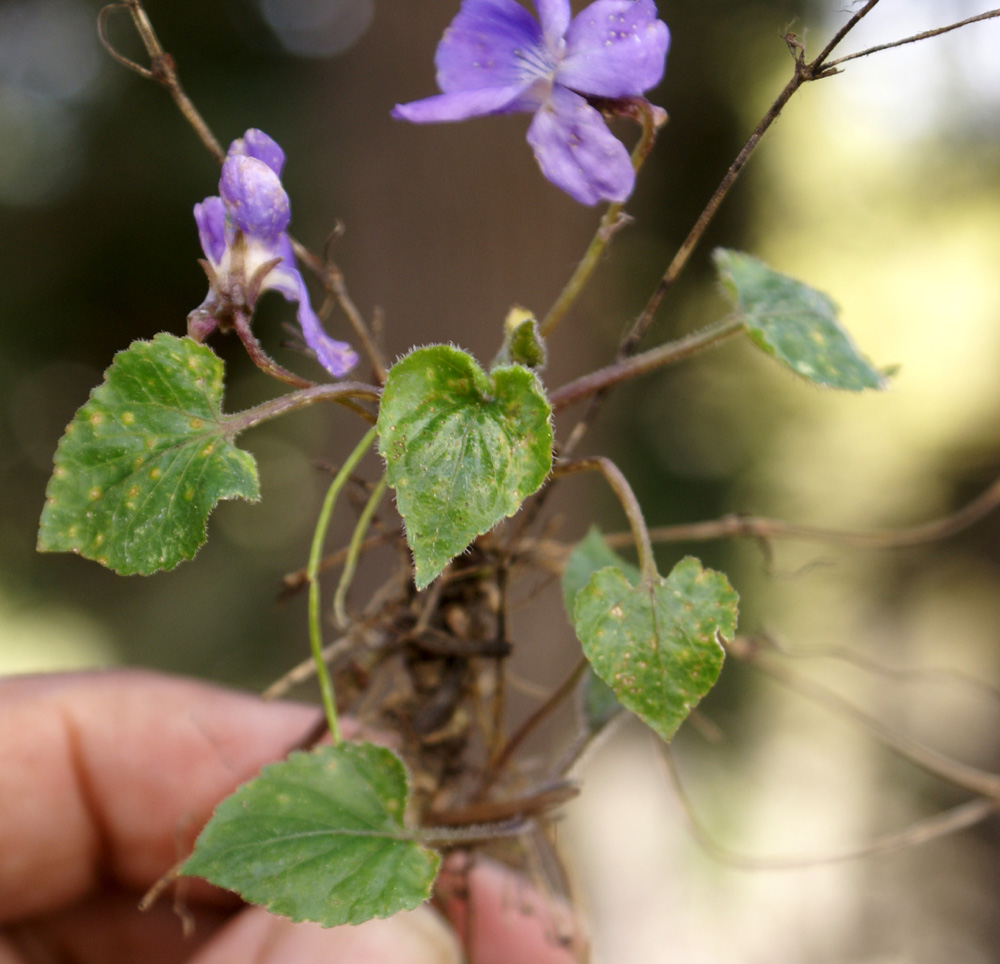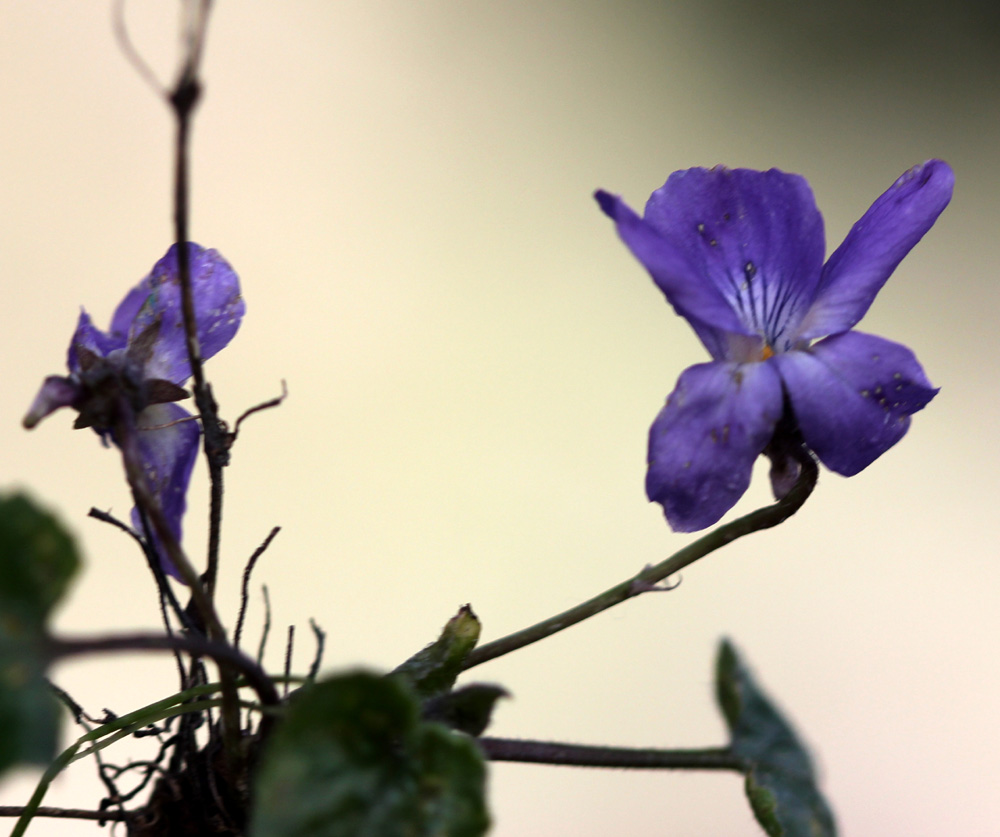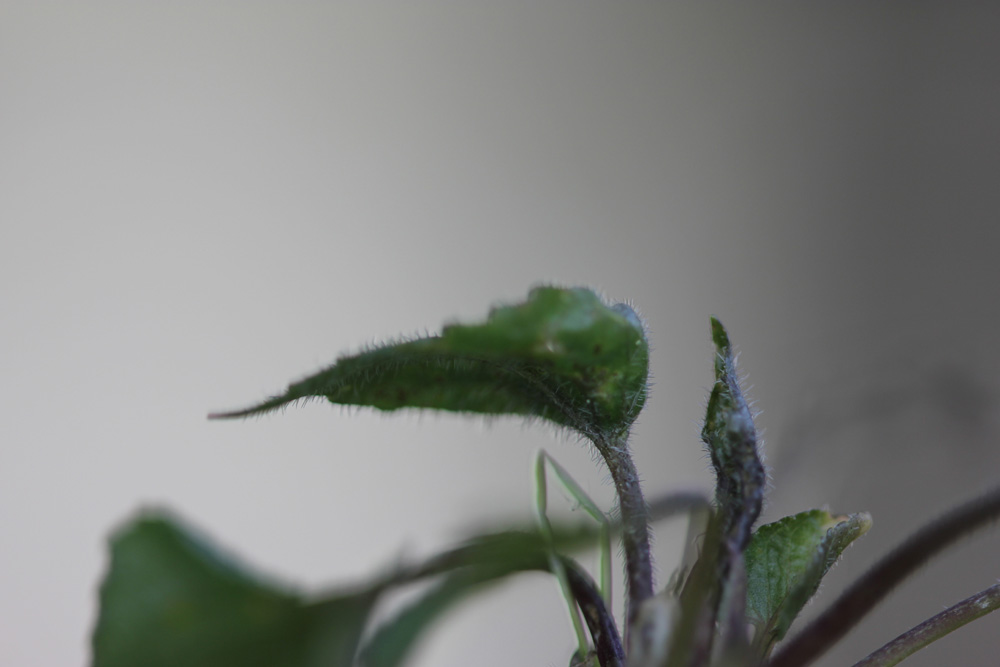|
Viola pilosa Blume, Catalogus 57 57 1823. (Syn: Viola aspera Ging. ex DC.; Viola buchaniana DC. ex D.Don; Viola burgersdijkii Oudem.; Viola celebica W.Becker; Viola crenata Moon; Viola dubia Wall. (ambiguous synonym); Viola glandulifera Wall. (ambiguous synonym); Viola glaucescens Oudemans; Viola griffithiana Boiss.; Viola palmaris Buch.-Ham. ex DC.; Viola pogonantha W.W. Sm.; Viola repens Buch.-Ham. ex Ging. (ambiguous synonym); Viola royleana Wall. (ambiguous synonym); Viola sarmentosa Burgersdijk (ambiguous synonym); Viola serpens Wall. (ambiguous synonym); Viola serpens Wall. ex Ging.; Viola serpens subsp. gurhwalensis W. Becker; Viola wightiana Wall.); There is a clear difference as to how style is visible in the live flowers in both species at Viola canescens and Viola pilosa
One more point is the nature of the lower petal being mostly acute or acuminate in Viola pilosa and obtuse in Viola canescens
I think the above three point combined together should clinch the id in most of the cases.
.
As per keys in Flora of Pakistan:
.
Keys as per Flora of Mizoram in efi thread:
Leaves broadly canescent, obtuse; flower pale-violet — Viola canescens
Leaves pilose, deltoid, acuminate; flowers white to bluish — Viola pilosa
.
ANMAR03/03 Viola sp. for identification : 10 posts by 4 authors. Attachments (6) Family: Violaceae It may be Viola odorata or Viola alba, not sure. efi page on Viola odorata Looks a lot like the Viola canescens we have here (Himachal) in the himalayas. Any key identifying features, sir? I can think of a couple off the top of my head. The lower petal is the smallest among all five. The tiny style (I am not sure if it could be called that) is yellow and tiny white hair cover the central upper surface where the petals meet. The flower overall is very pale violet, almost white. Thank you very much sir. This helps me a lot. Have you come across any other similar looking species of Viola? I am struggling with this family. A couple of times I thought I had seen V. canescens turned out to be not so. There is V. pilosa and another whose identity I am still not sure. Hopefully in good time I will be certain what to look for. These are very useful plants for food as well medicines. Dr Chauhan’s book on medicinal plants lists V. serpens, V. canescens, and V. odorata in use in Himachal Pradesh. Will definitely be glad to find out how to identify these Violas. Thank you. Please keep me updated! Leaves look more like Viola pilosa, but I think stipules are laciniate as in Viola canescens Stigma is not clear and appears more like Viola canescens
So it may be something else.
However, high resolution images are required to see the details correctly. I think it may be Viola pilosa Blume only.
I think stipules are variable.
Flora of China says stipules mostly free, brown or green, lanceolate, margin long or shortly fimbriate-dentate, apex long acuminate;
SK1177 06 JUNE 2018 : 12 posts by 4 authors. Attachments (6)
Location : Sukhiapokahari, Darjeeling, India
Date : 12 May 2018
Elevation : 6900 ft.
Habit : Wild
Viola again !
Yes, …. Beautiful images. Sir i think Viola Sp. Violaceae. Perhaps Viola canescens… Viola spp. But can’t go to the spp level.. Can also be Viola pilosa Blume, which is very confusing with Viola canescens Wall.
I am very excited to see this Viola with a 3-lobed stigma (and perhaps beaked too!) which according to Flowers of the Himalaya is found on V. pilosa. At least it gives credibility to FOH description which is different from eFloraofChina.
It is unfortunate that our main sources do not agree on the keys. FOH also says that leaf-blades are narrow and long, which clearly is not the case with Saroj ji’s plant, and stipules entire or toothed, not fringed, again differing from the plant in photos.
Since the plant is not hairy on petioles, leaf-blades and peduncles, I am inclined to rule out V. canescens.
I hope our experts will give a set of keys for the correct identification of Viola soon. Just found this nice paper on Viola. I could not download it on jStor as I am not affiliated with any institution and am not a subscriber. Perhaps someone on the group could download and share the pdf. Viola pilosa Bl. ?? : 8 posts by 3 authors. Attachments (6)- around 600 kb each.
Location : Lava, Kalimpong, India
Date : 11 May 2018
Elevation : 7000 ft.
Habit : Wild
Yes … It is sometimes difficult specially a lay person like me. I agree …, it is difficult for us to deal with difficult genera without expert help. I have been confounded by Viola and despite looking at our plants over and over again, I cannot decide between V. pilosa and V. canescens. Differing descriptions in Eflora of China, FOI and other literature does not help the case. Viola pilosa Bl. SK1169 03 JUNE 2018 : 4 posts by 2 authors. Attachments (2)
Location : Lava, Kalimpong, India
Date : 11 May 2018
Elevation : 7000 ft.
Habit : Wild
Which Viola ?? Stigma looks different from both Viola canescens Wall. as well as Viola pilosa Blume. OK …! Could you please show us a close up of the stigma if you happen to have it (or a higher res. of _DSC0651). It might be three-lobed and will be interesting to see. These are the only images I have ! Sorry! No problem … Was just excited by the possibility of a three-lobed stigma. Viola canescens Wall. (accepted name) ?? : 4 posts by 2 authors. Attachments (3) Location: Soureni, Mirik, India
Date: 21 April 2017
Altitude: 4200 ft. I think more likely to be Viola pilosa Blume rather than Viola canescens Wall. as per leaves. SK635 10 JUL-2017:ID : 6 posts by 2 authors. Attachments (6)
Location: Chowrasta, Darjeeling, India
Date: 21 May 2017
Altitude: 7000 ft.
Viola …. ???
Yes. Pl. Check comparative images in efi site. Appears closer to images at Viola canescens Wall. as per comparative images at Viola Thank you … I think more likely to be Viola pilosa Blume rather than Viola canescens Wall. as per leaves.
But can not be confirmed with these images Viola sikkimensis W.Becker ?? No.
I am really grateful to all the members of Indiatreepix for helping me with the identification of the plants that i have been posting. Once again i seek help.
I came across this particular delicate plant at an altitude of approximately 2100 mtrs. Can it be a member of Begoniaceae. Plz help with the identification
This is Viola, experts may confirm the species!! I dont have literatures right now!! 🙁 Himalayan White Violet (Viola canescens)? A was able to find only one plant of this at Manali. It is Veronica betonicifolia (Syn: V. patrinii). This one one has narrower leaves than canescens, thicker, nearly glabrous, not deeply cordate at base, and corolla with a short saccate spur (spur longer, slightly curved in V. canescence). You can view google images, illustrations of Efloras of China and Pakistan.
I think this should be Himalayan White Violet (Viola canescens) without doubt. This is the only Viola species with pale violet to almost white flowers found in the Himalayas at altitudes of 1500-2400 m. Please note that leaves in Viola canescens and V. betonicifolia are totally different. They are thicker, shining, glabrous with truncate to hastate base, where as they are deeply cordate and much broader, not shining. Also the spur in V. canescens is longer and slightly curved, where as it is shorter, saccate and straight in V. betonicifolia. As for the flower colour please note that flower colour varies from pale purple to violet, fading with age. Kindly compare leaves of V. canescens at FlowersofIndia website, Thanks for the detailed feedback. My perception of the flower color was based on Polunin & Stainton which describes the color of V. betonicifolia as violet. Indeed, Flora of Pakistan mentions it as lilac. Leaves are variable in both the species. The only difference I can clearly make out (for myself) is that leaves of V. betonicifolia are much longer than broad, and those of V. canescens are about as broad as long. It is good that our interaction on the website throws up interesting results. I must admit, you are a very keen observer. I was able to collect only and photograph of V. betonicifolia from Manali. I hope you will incorporate into FlowersofIndia the photographs I sent yesterday, and not represented at that website. I think more likely to be Viola pilosa Blume rather than Viola canescens Wall.
But can not be confirmed with these images.
Viola flowers – indiantreepix | Google Groups : 1 image. I think this is also Himalayan White Violet (Viola canescens). I think more likely to be Viola pilosa Blume rather than Viola canescens Wall.
But can not be confirmed with these images.
Wild Flower for ID – indiantreepix | Google Groups : 1 image. Himalayan White Violet (Viola canescens) I think more likely to be Viola pilosa Blume rather than Viola canescens Wall.
But can not be confirmed with these images.
SK1849 20 April 2019 : 3 posts by 2 authors. Attachments (7)- around 550 kb each.
Location: Nagarjun Forest reserve, Kathmandu Habit : Wild
Viola pilosa Blume ??
Viola pilosa Blume and Viola canescens Wall. are confusingly similar.
Pl. check details and keys etc. to confirm. I guess V. pilosa leaves are more pointed compared to V. canescens. Leaves are more like Viola pilosa Blume and stigma is more like Viola canescens Wall.
But stipules are different from both.
So something different. Viola sikkimensis W.Becker ?? I think pistil looks different from FOC illustration I checked keys in Flora of Bhutan at Viola
It leads me to Viola pilosa Blume only.
Flora of China says stipules mostly free, brown or green, lanceolate, margin long or shortly fimbriate-dentate. MS March, 2020/09 Viola sp. ?? for ID : 6 posts by 2 authors. Attachments (3)- 1 mb each. Location : Hmuifang, Mizoram Date : 15-04-2019
Habit : Herb
Habitat : Wild
I think some Viola species.
What are the species reported from your area ?
Viola betonicifolia subsp. betonicifolia, V.canescens, V. hamiltoniana, V.pilosa & V.thomsonii are recorded in Mizoram.
Thanks, … Any keys ?
Possibility of Viola pilosa Blume is there. SK1232 25 JUNE 2018 : 4 posts by 2 authors. Attachments (8)- around 500 kb each.
Location: Sakiyong Khasmahal, Pedong Reshi Rd, India
Date: 16 May 2018
Altitude: 5800 ft.
Habit : Wild
Looks like flowers are spoil by rain of this Viola sp. Possibility of Viola pilosa is there. Viola sp. for id, Upper Dzongu, Sikkim – 2015. : 4 posts by 3 authors. Attachments (2)
Please identify this Viola sp. from North Sikkim, found on mountain slope, between dense vegetation. Viola species in eFloraofindia (with details/ keys from published papers/ regional floras/ FRLHT/ FOI/ Biotik/ efloras/ books etc., where ever available on net) Very difficult …, There are 18 species recorded for Sikkim and without further details mainly nature of stipules, lower surface of leaves, size of flowers, details of subterranean parts etc. it is not possible to identify the species without prior acquaintance. It could be the common species Viola glaucescens! It must be from temperate meadows. Thank you … for the inputs. It was found between 2000-2800 asl.
Possibility of Viola pilosa Blume is there. MS March, 2019/07 Viola sp. for Id. : 7 posts by 4 authors. Attachments (1) Date : 20-03-2019
Habit : Small herb
Habitat : Wild.
probably Viola odorata ?
Looks different to me from images at Viola odorata L.
Also could not find a match at comparative images at Viola
Hi, …, What are the species found in your area ?
Viola betonicifolia subsp. betonicifolia, V.canescens, V.hamiltoniana, V.pilosa & V.thomsonii are found in Mizoram.
I don’t know either. but its leaves do not look like this which is listed as Viola betonicifolia subsp. betonicifolia – Arrowhead Violet,
Native Violet, Showy Violet, Mountain Violet
Looks different from Viola hamiltoniana as per
I could not find images of Viola thomsonii. Pl. check with specimens at
May I request you to pl. post high resolution images to see the details.
If any other images, pl. post them also. Thanks, … Pl. post the keys from your book. Attachments (1) – 4 mb I can neither see the stipules nor the bracteolates.
However, Viola pilosa Blume is possible.
72-TSP-ID-06JUN2016-2: Herb @ Mullaianagiri for ID. : 7 posts by 3 authors. Attachments (3)
Kindly identify this herb. Habit: Herb Habitat: Wild, Evergreen forest floor with rich humus Sighting: Mullaianagiri, Chikmagalur, Karnataka, about 1700 msl. Date: 04-06-2016 Viola sp. Viola species in eFloraofindia (with details/ keys from published papers/ regional floras/ FRLHT/ FOI/ Biotik/ efloras/ books etc., where ever available on net) Saroj ji’s image at Flickr : 2 posts by 2 authors.
Saroj ji’s image at Flickr is of V.pilosa and not of Viola indica. Done!
Viola For ID : Nainital,Uttarakhand : 200513 : AK-1 : Attachments (2). 6 posts by 2 authors. Can this be Viola canescens, common name Himalayan White Viola as in flowersofindia?
Experts kindly confirm id. efi page on Viola canescens seems to me viola canescens Thanks to … for follow up and confirmation of id. Lower petal and habit suggests V. pilosa Viola pilosa Blume
syn: V. serpens Wall.
Species differentiated by acuminate pilose leaves , lanceolate acute calyx, style beaked, curved downwards.
Photographed from Khillenmarg, Kashmir, 28-5-2012 . MS,Oct.,2021/75 Viola sp. ? for id.:
Location : Hmuifang, Mizoram Date : 16-04-2019
Habit : Herb
Habitat : Wild Viola pilosa Blume ??? Yes. Same as at MS March, 2020/09 Viola sp. ?? for ID . Viola pilosa Blume: 3 very high res. images. Location: Dailekh, West Nepal
Altitude: 2000 m.
Date: 28 June 2021
Habit : Wild . Viola pilosa Blume: 7 very high res. images. Location: Timure, Surkhet, Nepal
Altitude: 2100m.
Date: 22 March 2022
Habit : Wild . Viola canescens Wall.: 2 images. I think it is (as per images and keys herein) . MS,Jan.,2023/21 Herb for id.: 2 images. Altitude : ca.1,350 m
Date : 19-01-2023
Habit : Small herb
Habitat : Wild Viola : https://efloraofindia.com/2011/04/05/viola/ I think close to images at Viola pilosa Blume . Viola pilosa Blume: 5 very high res. images.
Location: Taplejung, East Nepal Habit : Wild Images sent by Mr. Sajan Subedi ! . MS April,2024/07 Viola sp. for id.: 1 image.
Location : Lengteng, Mizoram Altitude :ca.1,650 m
Date : 11-04-2024
Habit : Herb
Habitat : Wild
I think close to images at Yes! It’s close . Sattal May 2025 :: Viola for ID :: ARK2025-043: 3 high res. images. I guess the ID is correct. .
Sattal May 2025 :: Viola -2 for ID :: ARK2025-045: 2 high res. images. This was near Sattal, Nainital, Uttarakhand in May 2025.
Is this also V. canescens? Kindly validate
I guess the ID is correct. I think this is an old, almost weathered specimen.
Style is not club shaped (from what I can see), so can not V. canescens.
It is more likely to be same as your another post from the same area of
https://efloraofindia.com/efi/viola-pilosa/ . References:
|
Viola pilosa
Updated on August 18, 2025


